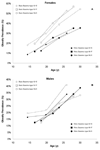Longitudinal trends in obesity in the United States from adolescence to the third decade of life
- PMID: 20035278
- PMCID: PMC2929301
- DOI: 10.1038/oby.2009.451
Longitudinal trends in obesity in the United States from adolescence to the third decade of life
Abstract
No longitudinal analyses using national data have evaluated the increase in obesity from adolescence into early adulthood. We examined obesity incidence, persistence, and reversal in a nationally representative cohort of US teens followed into their early 30s, using measured height and weight data, in individuals enrolled in wave II (1996; 12-21 years), wave III (2001; 17-26 years), and wave IV (2008 early release data; 24-32 years) of the National Longitudinal Study of Adolescent Health (N = 8,675). Obesity was defined as a BMI >or=95th percentile of the 2000 Centers for Disease Control/National Center for Health Statistics growth charts or >or=30 kg/m(2) for individuals <20 years and >or=30 kg/m(2) in individuals >or=20 years. In 1996, 13.3% of adolescents were obese. By 2008, obesity prevalence increased to 36.1%, and was highest among non-Hispanic black females (54.8%). Ninety percent of the obese adolescents remained obese in 2008. While annual obesity incidence did not decline in the total sample across the two study intervals (2.3% per year 1996-2001 vs. 2.2% per year 2001-2008), rates among white females declined (2.7 to 1.9% per year) and were highest among non-Hispanic black and Hispanic females (3.8 and 2.7% per year, 1996-2001 vs. 3.0 and 2.6% per year, 2002-2008, respectively). Obesity prevalence doubled from adolescence to the early 20s, and doubled again from the early to late 20s or early 30s, with strong tracking from adolescence into adulthood. This trend is likely to continue owing to high rates of pediatric obesity. Effective preventive and treatment efforts are critically needed.
Figures

References
-
- Ogden CL, Carroll MD, Curtin LR, McDowell MA, Tabak CJ, Flegal KM. Prevalence of overweight and obesity in the United States, 1999–2004. JAMA. 2006;295:1549–1555. - PubMed
-
- Gordon-Larsen P, McMurray RG, Popkin BM. Adolescent physical activity and inactivity vary by ethnicity: The National Longitudinal Study of Adolescent Health. J Pediatr. 1999;135:301–306. - PubMed
-
- Gordon-Larsen P, Adair LS, Nelson MC, Popkin BM. Five-year obesity incidence in the transition period between adolescence and adulthood: the National Longitudinal Study of Adolescent Health. Am J Clin Nutr. 2004;80:569–575. - PubMed
-
- Must A, Anderson SE. Body mass index in children and adolescents: considerations for population-based applications. Int J Obes (Lond) 2006;30:590–594. - PubMed
Publication types
MeSH terms
Grants and funding
LinkOut - more resources
Full Text Sources
Medical

